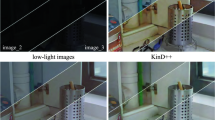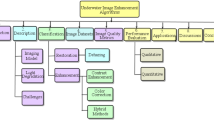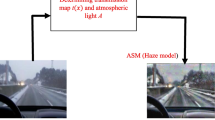Abstract
In this paper, a novel multidimensional underwater video dehazing method is presented to restore and enhance the underwater degraded videos. Videos in the underwater suffer from medium scattering and light absorption. The absorption of light traveling in the water makes the underwater hazing videos different from the atmosphere hazing videos. In order to dehaze the underwater videos, a spatial–temporal information fusion method is proposed which includes two main parts. One is transmission estimation, which is based on the correlation between the adjacent frames of videos to keep the color consistency, where fast tracking and the least square method are used to reduce the influence of camera and object motions and water flowing. Another part is background light estimation to keep consistent atmospheric light values in a video. Extensive experimental results demonstrate that the proposed algorithm can have superior haze removing and color balancing capabilities.








Similar content being viewed by others
References
Ancuti, C., Ancuti, C. O., Haber, T., & Bekaert, P. (2012). Enhancing underwater images and videos by fusion. In 2012 IEEE Conference on Computer vision and Pattern Recognition (CVPR) (pp. 81–88). IEEE.
Chao, L., & Wang, M. (2010). Removal of water scattering. In 2010 2nd International Conference on Computer Engineering and Technology (ICCET) (Vol. 2, pp. v2–35). IEEE.
Chiang, J. Y., & Chen, Y.-C. (2012). Underwater image enhancement by wavelength compensation and dehazing. IEEE Transactions on Image Processing, 21(4), 1756–1769.
Guo, F., Cai, Z.-X., & Xie, B. (2011). Video defogging algorithm based on fog theory. Dianzi Xuebao(Acta Electronica Sinica), 39(9), 2019–2025.
Han, J., Zhang, D., Hu, X., Guo, L., Ren, J., & Wu, F. (2015). Background prior-based salient object detection via deep reconstruction residual. IEEE Transactions on Circuits and Systems for Video Technology, 25(8), 1309–1321.
He, K., Sun, J., & Tang, X. (2009). Single image haze removal using dark channel prior. In IEEE Conference on Computer Vision and Pattern Recognition, 2009. (CVPR’2009) (pp. 1956–1963). IEEE.
He, K., Sun, J., & Tang, X. (2010). Guided image filtering. In Proceedings of the 11th European Conference on Computr Vision: Part I (pp. 1–14). Springer.
Hou, W., Gray, D. J., Weidemann, A. D., Fournier, G. R., & Forand, J. (2007). Automated underwater image restoration and retrieval of related optical properties. In IEEE International Geoscience and Remote Sensing Symposium, 2007 (IGARSS’2007) (pp. 1889–1892). IEEE.
Hu, X., Zhuo, L., & Li, X. (2014). A moving objects based real-time defogging method for traffic monitoring videos. In 2014 19th International Conference on Digital Signal Processing (DSP’2014) (pp. 1–6). IEEE.
Kim, J.-H., Jang, W.-D., Sim, J.-Y., & Kim, C.-S. (2013). Optimized contrast enhancement for real-time image and video dehazing. Journal of Visual Communication and Image Representation, 24(3), 410–425.
Koschmieder, H. (1925). Theorie der horizontalen Sichtweite: Kontrast und Sichtweite. Munich: Keim & Nemnich.
Lebart, K., Smith, C., Trucco, E., & Lane, D. M. (2003). Automatic indexing of underwater survey video: Algorithm and benchmarking method. IEEE Journal of Oceanic Engineering, 28(4), 673–686.
Ouyang, B., Dalgleish, F. R., Caimi, F. M., Vuorenkoski, A. K., Giddings, T. E., & Shirron, J. J. (2012). Image enhancement for underwater pulsed laser line scan imaging system. In Proceedings of SPIE 8372, Ocean Sensing and Monitoring IV, p. 83720R.
Ren, J., Jiang, J., Wang, D., & Ipson, S. S. (2010). Fusion of intensity and inter-component chromatic difference for effective and robust colour edge detection. IET Image Processing, 4(4), 294–301.
Schechner, Y. Y., & Averbuch, Y. (2007). Regularized image recovery in scattering media. IEEE Transactions on Pattern Analysis and Machine Intelligence, 29(9), 1655–1660.
Serikawa, S., & Lu, H. (2014). Underwater image dehazing using joint trilateral filter. Computers and Electrical Engineering, 40(1), 41–50.
Tarel, J.-P., Hautière, N. (2009). Fast visibility restoration from a single color or gray level image. In IEEE 12th International Conference on Computer vision, 2009 (pp. 22010–2208). IEEE.
Tarel, J.-P., Hautière, N., Cord, A., Gruyer, D., Halmaoui, H. (2010). Improved visibility of road scene images under heterogeneous fog. In Intelligent Vehicles Symposium (IV), 2010 IEEE (pp. 478–485). IEEE.
Yuh, J., & West, M. (2001). Underwater robotics. Advanced Robotics, 15(5), 609–639.
Zhang, J., Li, L., Zhang, Y., Yang, G., Cao, X., & Sun, J. (2011). Video dehazing with sapatial and temporal coherence. The Visual Computer, 27(6–8), 749–757.
Zhang, E., Lv, K., Li, Y., & Duan, J. (2013). A fast video image defogging algorithm based on dark channel prior. In 2013 6th International Congress on Image and Signal Processing (CISP’2013) (Vol. 1, pp. 219–223). IEEE.
Zhang, K., Zhang, L., Liu, Q., Zhang, D., & Yang, M.-H. (2014). Fast tracking via dense spatio-temporal context learning. In Computer Vision-ECCV 2014 (pp. 127–141). Springer.
Author information
Authors and Affiliations
Corresponding author
Rights and permissions
About this article
Cite this article
Qing, C., Yu, F., Xu, X. et al. Underwater video dehazing based on spatial–temporal information fusion. Multidim Syst Sign Process 27, 909–924 (2016). https://doi.org/10.1007/s11045-016-0407-2
Received:
Revised:
Accepted:
Published:
Issue Date:
DOI: https://doi.org/10.1007/s11045-016-0407-2




